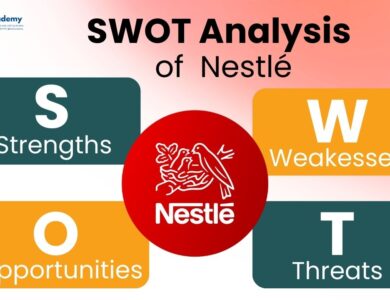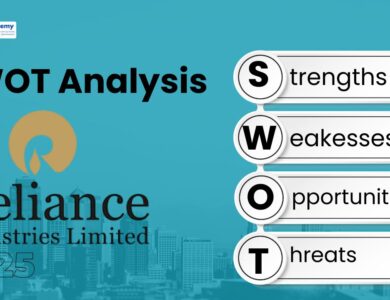SBI (State Bank of India) SWOT Analysis: What Makes It a Market Leader?
"Explore SBI’s SWOT analysis to understand its market leadership, strengths, key challenges, and future opportunities in India’s competitive banking sector."

When we talk about banking in India, one name that inevitably pops up is SBI – State Bank of India. Whether you’re opening your first savings account, applying for a home loan, or using UPI for your daily payments, chances are, SBI has touched your financial journey in some way.
But beyond the sheer familiarity, have you ever wondered what really makes SBI a dominant force in the Indian banking ecosystem? Or what challenges it quietly battles behind the scenes?
That’s where a SWOT analysis comes in – a powerful tool to break down SBI’s Strengths, Weaknesses, Opportunities, and Threats in a structured way.
In this article, we’ll walk you through a detailed SWOT Analysis of SBI in 2025, backed by current trends, expert insights, and real-world implications.
Whether you’re a business student, an investor, a competitive exam aspirant, or just someone curious about India’s financial system, this deep dive will give you a fresh, 360-degree view of how SBI is positioned today — and what the road ahead might look like.
So, let’s roll up our sleeves and decode the bank that manages the money of over 45 crore customers and holds a pivotal place in India’s economy.
Learn AI & Digital Marketing,
Pay Fees After Placement
- ✅ Minimal Admission Fees
- ✅ No Loan or Income Sharing Agreement
- ✅ 100% Placement Support
- ✅ ISO & Govt Registered Certificate
- ✅ Practical 3+1 Months Duration
Get a free counseling call. We’ll guide you through learning, certification, and job placement.
Request a Free Call Back
Takes less than a minute.
What is SWOT Analysis?
Before we dive into SBI’s strengths and challenges, let’s quickly understand what a SWOT analysis actually is — and why it’s so useful.
SWOT stands for:
- S – Strengths
- W – Weaknesses
- O – Opportunities
- T – Threats
Think of it as a business health checkup. Just like a doctor evaluates your vitals, a SWOT analysis evaluates a company’s internal capabilities (its strengths and weaknesses) and its external environment (the opportunities and threats around it).
- Strengths and Weaknesses are internal factors. These are things SBI can control – like its brand value, customer base, technology, employee structure, and more.
- Opportunities and Threats are external. These come from outside the organization – like economic changes, market trends, new government policies, or emerging competitors.
So why does it matter?
Because understanding SWOT helps organizations like SBI make smarter decisions. Should they invest more in digital banking? Should they improve rural outreach? Are private banks eating into their market share? SWOT brings these questions into the spotlight.
And the best part? A good SWOT analysis doesn’t just tell you where a company stands today — it helps forecast where it could be headed tomorrow.
Now that we’ve set the stage, let’s begin with the Strengths of SBI — the pillars that make it the banking behemoth of India.
Also Read: Complete SWOT Analysis of Mahindra – How the Brand Continues to Lead the Indian Market
Strengths of SBI
SBI isn’t just India’s largest public sector bank by size—it’s a banking institution that shapes the financial heartbeat of the nation. But what really powers this giant? Let’s look at the core strengths that keep SBI miles ahead of many of its competitors:
-
Massive Customer Base & Branch Network
SBI serves over 45 crore customers—yes, you read that right. It operates through more than 22,000 branches and over 60,000 ATMs across the country. From bustling metros to remote villages, SBI has a footprint almost everywhere, making it India’s most accessible bank.
This widespread reach gives it an edge in customer trust, rural banking, and government-linked schemes.
-
Strong Government Backing
Being a government-owned entity, SBI enjoys a sense of reliability and stability that private banks often struggle to match. Whether it’s subsidies, pensions, or loan disbursements, SBI is the go-to bank for government transactions—giving it an unmatched edge in public trust.
-
Diversified Services Portfolio
SBI isn’t just a savings account provider. It offers everything from retail and corporate banking to insurance, mutual funds, wealth management, and even investment banking. This diversified portfolio allows it to serve everyone—from salaried employees to large-scale enterprises.
-
Leadership in Digital Banking
Gone are the days when public sector banks lagged behind in tech. SBI’s digital platform YONO (You Only Need One) is a powerful, all-in-one app that handles everything from fund transfers to online shopping.
In fact, SBI is among the most digitally active banks in India, clocking billions in UPI transactions and digital payments every month.
-
High Brand Recognition & Trust
Ask anyone in India to name a bank—they’ll probably say “SBI” first. That’s brand power. Decades of service, familiarity, and a perception of being “safe” make SBI a household name. This trust translates into long-term customer loyalty and repeat business.
-
Scale of Operations
SBI’s massive size allows it to leverage economies of scale. It can afford lower interest rates, absorb policy shifts better, and negotiate from a position of strength when it comes to partnerships or tech upgrades.
Also Read: Sony SWOT Analysis: Key Business Strategies & Market Challenges
Weaknesses of SBI
No matter how strong a brand is, no organization is without its flaws — and SBI is no exception. Despite its dominance, there are areas where SBI struggles to keep up, especially when compared to agile private sector banks and fintech players.
Let’s explore the key weaknesses that SBI needs to address to stay future-ready:
-
Slower Decision-Making & Bureaucracy
Being a government-owned bank comes with layers of procedures, approvals, and red tape. Unlike private banks that can pivot quickly, SBI often faces delayed decision-making, which can slow down innovation, customer service improvements, and response to market trends.
-
High Non-Performing Assets (NPAs)
SBI has historically battled higher levels of NPAs (loans that don’t get repaid) compared to many private banks. While steps have been taken to clean up its books, bad loans from corporate and agricultural sectors still pose a serious threat to profitability and investor confidence.
-
Overstaffing & HR Challenges
With a workforce of over 2.5 lakh employees, managing efficiency is a real challenge. Training, upskilling, and adapting to new-age banking methods takes time, especially when a large portion of the staff is used to traditional workflows.
-
Customer Service Concerns
Ask around, and you’ll hear mixed reviews about SBI’s customer service. Long queues, delayed responses, and inconsistent branch experiences have led to reputation issues, especially among tech-savvy younger customers who prefer smoother, digital-first experiences.
-
Legacy Systems in Rural Areas
While SBI is strong in digital banking in urban areas, many rural branches still operate on outdated infrastructure and manual systems. This not only affects operational efficiency but also makes it harder to bring uniform service quality across the board.
-
Limited Global Expansion
Compared to global giants like HSBC or Citibank, SBI’s international presence is still modest. While it does operate in over 30 countries, its global market share is relatively small, limiting its exposure to international banking opportunities.
SBI’s weaknesses lie in its scale-related challenges, outdated systems in parts of its network, and its struggle to modernize fast enough in the face of fierce private and digital competition.
Also Read: Royal Enfield SWOT Breakdown: How the Brand Dominates the Mid-Size Bike Market
Opportunities for SBI
In a rapidly changing financial world, challenges aren’t just roadblocks—they’re also launchpads for new growth. SBI, with its massive base and credibility, is in a unique position to unlock a range of opportunities that could not only future-proof the brand but also help it scale newer heights.
Let’s dive into the most promising opportunities SBI can seize in 2025 and beyond:
-
Rural & Semi-Urban Market Penetration
Even today, a large chunk of India’s rural population remains underbanked or unbanked. With its already strong rural presence, SBI can deepen its services like credit, insurance, and digital banking in tier 2, 3, and rural markets—an area where private banks still lag behind.
This is not just a business opportunity, but a chance to lead India’s financial inclusion mission.
-
Digital Transformation & Fintech Collaborations
SBI has already made strides with platforms like YONO, but the journey is far from over. With AI, machine learning, blockchain, and big data transforming global banking, SBI has the chance to leapfrog competition by partnering with fintech startups and building smarter, faster, more personalized banking experiences.
-
Expanding Global Footprint
With millions of Non-Resident Indians (NRIs) and Indian-origin businesses overseas, there’s massive untapped potential for SBI in international banking. Strengthening its presence in the US, UK, Middle East, and Southeast Asia can open up new revenue streams and cross-border opportunities.
-
SME & Startup Financing
India’s startup ecosystem is booming, and SBI can position itself as the go-to bank for small businesses and entrepreneurs. With tailored loan products, advisory services, and credit evaluation tech, SBI can become a backbone for the new India economy.
-
Upskilling & Human Capital Development
With such a massive workforce, SBI has the opportunity to upskill its employees and transform them into digital-first banking professionals. Investing in learning, AI-powered systems, and automation training can significantly improve efficiency and service quality.
-
Green Banking & Sustainable Finance
As climate change becomes a pressing concern, there’s a growing push toward environmentally responsible banking. SBI can lead this space in India by funding green infrastructure projects, solar initiatives, and offering incentives for sustainable businesses.
From deeper rural penetration and global expansion to fintech innovation and green banking, SBI’s future is filled with possibilities. If leveraged right, these opportunities could reshape SBI into a truly future-ready financial powerhouse.
Also Read: In-Depth SWOT Analysis of Axis Bank – India’s Leading Private Sector Bank
Threats to SBI
In a dynamic economy like India’s—and a global financial ecosystem that’s constantly evolving—even a banking leader like SBI must watch its back. From rising competition to technological risks, there are several external forces that could challenge SBI’s growth, stability, and relevance.
Here are some of the key threats that SBI must be cautious of in 2025 and beyond:
-
Intensifying Competition from Private Banks and Fintechs
Private banks like HDFC, ICICI, and Axis are not just tech-savvy, but also quicker to roll out new services, mobile apps, and customer support tools. Add to that the rise of fintech startups like Paytm, PhonePe, and Razorpay, and SBI is suddenly surrounded by fast, flexible challengers eating into its market share.
-
Rapid Technological Disruption
Banking is no longer just about branches—it’s about AI chatbots, robo-advisors, blockchain-based transactions, and digital-only experiences. If SBI doesn’t keep up with these advancements, it risks becoming less relevant to the tech-driven customer of today.
-
Cybersecurity Risks
With great digital power comes great digital responsibility. As more customers move to online banking, SBI becomes a prime target for cyberattacks. Data breaches, fraud, and phishing scams could not only cause financial losses but seriously damage customer trust.
-
Economic Slowdowns & Policy Shocks
High inflation, policy changes by the RBI, or a global financial crisis can hit banks hard—especially public sector ones like SBI. A weak economy means lower loan demand, higher defaults, and reduced profitability.
-
Political Interference & Regulatory Pressure
As a state-owned bank, SBI often walks a tightrope between commercial logic and political decisions. Loan waivers, forced mergers, or changes in credit policy for political reasons can lead to misaligned priorities and poor asset quality.
-
Changing Customer Expectations
Today’s customers expect 24/7 support, instant approvals, and frictionless digital experiences. If SBI can’t match the speed and simplicity of newer banks or apps, it risks losing young and urban customers to competitors who speak their language.
SBI stands tall, but the world around it is shifting fast. From cyber threats and nimble competition to economic volatility and regulatory challenges, the road ahead isn’t smooth—but with awareness and agility, it’s one SBI can surely navigate.
Conclusion
The State Bank of India (SBI) is more than just a bank — it’s a symbol of trust, tradition, and transformation in Indian banking. As we’ve seen through this detailed SWOT analysis, SBI holds some of the strongest cards in the game — from unmatched reach and public trust to an evolving digital presence.
But like any giant, it faces its own set of internal hurdles and external headwinds. Slow bureaucratic processes, rising NPAs, and customer service concerns must be actively addressed if it wants to remain a market leader in the age of instant apps and intelligent banking.
At the same time, opportunities are knocking louder than ever — deeper rural outreach, fintech tie-ups, sustainable banking, and global growth can all turn SBI into a future-ready powerhouse. But only if it moves with the agility of a startup and the vision of a legacy institution.
So, whether you’re a student preparing for your MBA or UPSC, a business analyst evaluating the sector, or a customer curious about your bank’s future, SBI’s SWOT analysis offers valuable lessons in leadership, resilience, and reinvention.
Because at the end of the day, even the biggest bank must keep evolving—or risk becoming history.





